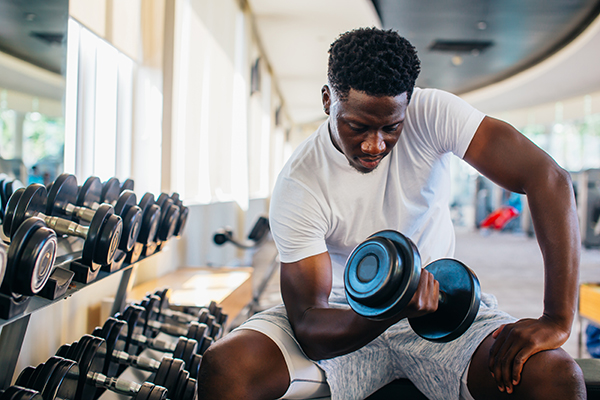What Is Muscle Hypertrophy?

We get a lot of weightlifting program questions. One of the most common ones involves the term hypertrophy. Sounds intimidating, doesn’t it?
Basically, when it comes to fitness, hypertrophy is the growth and increase in the size of muscle cells.
“Gaining muscle and keeping muscle is something that takes continuous work,” says exercise physiologist Jackie S. Womble.
Hypertrophy training is an effective way to do this. Do it right, and you’ll reap the rewards, including stronger bones and a slower rate of age-related muscle loss.
Learn more about hypertrophy and what it means for your fitness goals.

What Is Hypertrophy?
Generally speaking, hypertrophy means making any organ or tissue bigger by increasing the size of the cells. “What people typically mean in fitness is the growth of muscles,” explains Kristian Flores, CSCS.
“Muscular hypertrophy occurs by placing work on the muscles through movement and exercise, which cause an increase and growth in muscle cells,” says Womble. “When muscles are worked to the point where mechanical damage occurs, the body’s repair response happens.”
The healing process that mends these muscle fibers results in them getting slightly bigger. Over time, the muscles keep getting bigger.
To see those gains, it comes down to time and load, explains Flores.
You have to lift a heavy enough weight enough times to cause the tension and stress needed for your body to produce hormones required to dial-up muscle protein synthesis, the process underlying muscle growth.
But nutrition matters, too. You have to have “enough materials for the addition of more size to the muscle,” says Flores.
Your diet needs to provide enough protein and carbs, consumed at the right time.

Types of Hypertrophy Training
There are two types of hypertrophy: sarcoplasmic and myofibrillar.
Sarcoplasmic hypertrophy (i.e., an increase in the volume of sarcoplasmic fluid inside the muscle cell) is more likely to build muscle thickness. This is often referred to as training for size.
That’s in contrast to training for strength, the goal of which is to achieve myofibrillar hypertrophy. This type of hypertrophy involves the growth of muscle fibers.
Hypertrophy training for size typically uses higher rep ranges with a lower weight. This is a training style associated with bodybuilders.
The goal is to get in a good amount of volume before you hit muscle exhaustion. In practice, that may mean using a weight that feels challenging but not exhausting for 12-15 reps for 3-6 sets.
“When you increase the load and the number of sets you perform, you are asking the muscle tissue to rebuild bigger and stronger to accommodate for the increased demands,” explains Cody Braun, CPT.
Flores says beginners will require fewer sets than advanced lifters. Adding sets isn’t the only way to increase volume, though.
You can increase the reps or sets you perform, shorten your rest to do more work in the same amount of time, train a body part multiple times a week, or adjust how many exercises per muscle group you work during your workouts.
Hypertrophy training for strength, on the other hand, typically uses lower reps with higher weight.
Powerlifters generally use this style of training. This type of work requires efforts close to your maximum effort for 1-5 reps for 3-6 sets. This type of training requires much longer rest periods.
You can also combine these two styles of training.
“You can pair endurance-based rep schemes with maximal-strength rep schemes to get the amount of load and volume necessary for hypertrophic adaptations,” Braun explains. “You can exhaust muscles to fatigue, and you can also lift heavy to stimulate the bigger muscle fibers that are more susceptible to grow.”

Hypertrophy vs. Strength Training
So how is hypertrophy different from regular old strength training? ”
Hypertrophy refers to an increase in muscle size whereas strength training is achieving increased strength from the muscles,” Womble explains.
And, adds Braun, strength training is more focused on performance (lifting heavier weights), while hypertrophy training emphasizes volume.
Since these training styles have different goals, they commonly use different techniques to achieve them.
Womble explains that these training styles differ in three main ways: volume, intensity, and rest.
“When focused on hypertrophy, the training volume is increased, and training intensity and rest between sets are decreased,” she says. “In strength training, the training volume is decreased while intensity and rest between sets are increased.”
In terms of actual weight used, Braun and Flores explain that strength training requires working at 85%-100% of your maximum effort, which means low reps with long rest periods.
Hypertrophy training requires working closer to 65% of your maximum effort.
(If you’re just getting started, check out our strength training for beginners guide.)
Flores adds that strength training “focuses on central nervous system adaptation to improve strength.”
But, he adds, “there’s only so much work your central nervous system can take, which means people doing strength training will likely also have to do hypertrophy work, while those who focus on volume don’t necessarily ever need to train maximum-effort strength.
If you’re ready to tackle some heavy weights, an at-home workout program like LIIFT4 may be right for you.
Looking for more at-home workouts? Here’s how to find the BODi program that’s the perfect fit for your goals.
